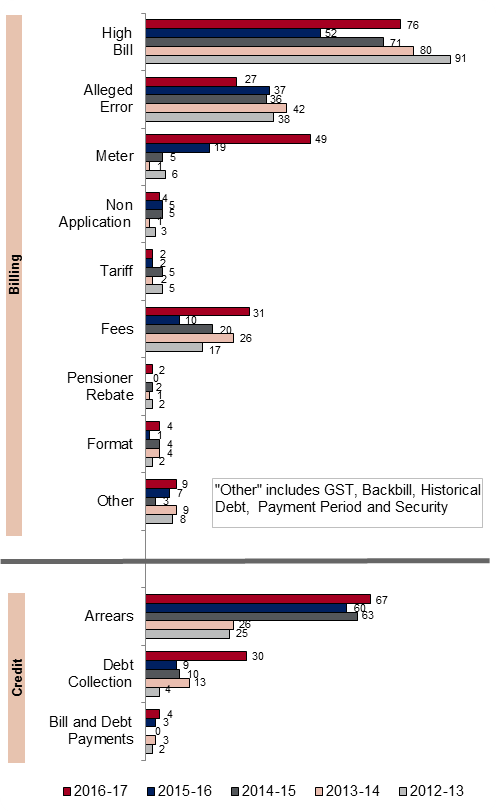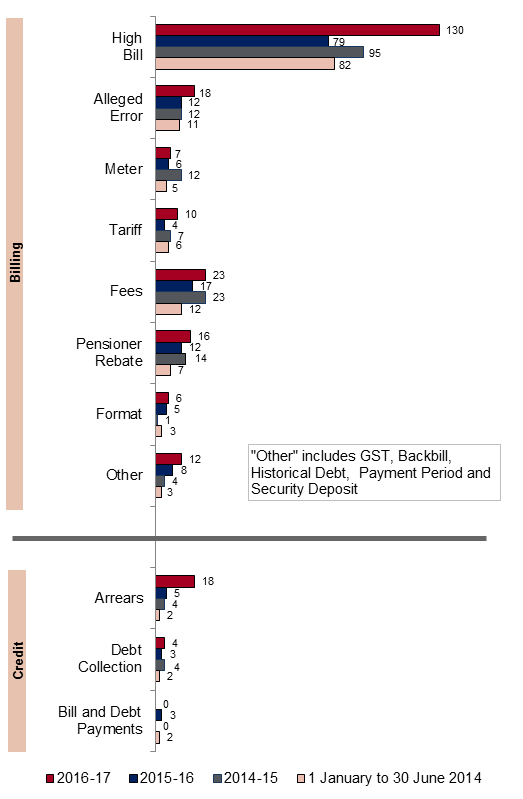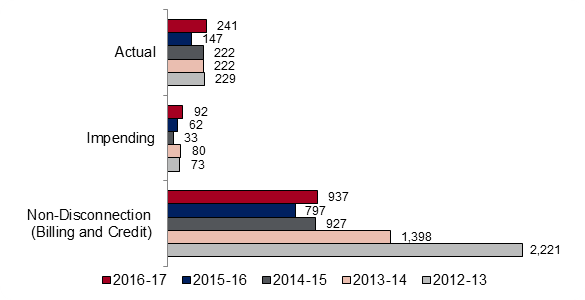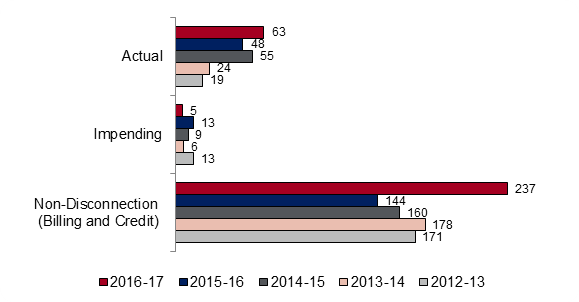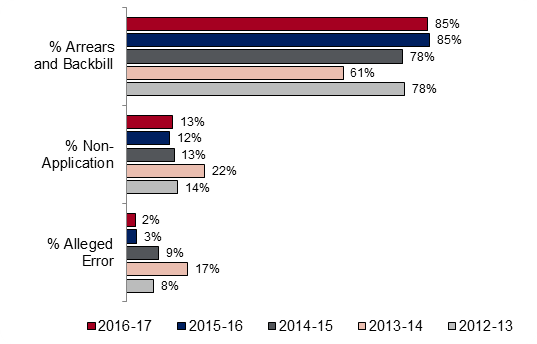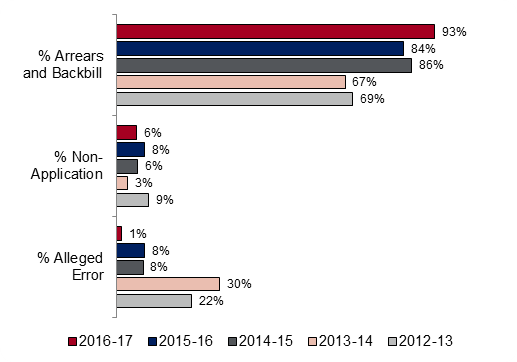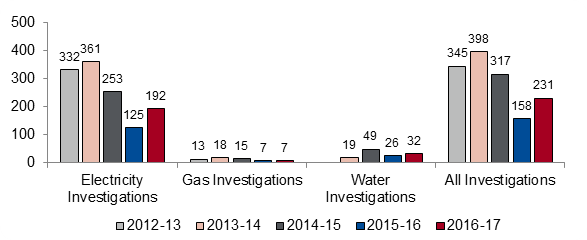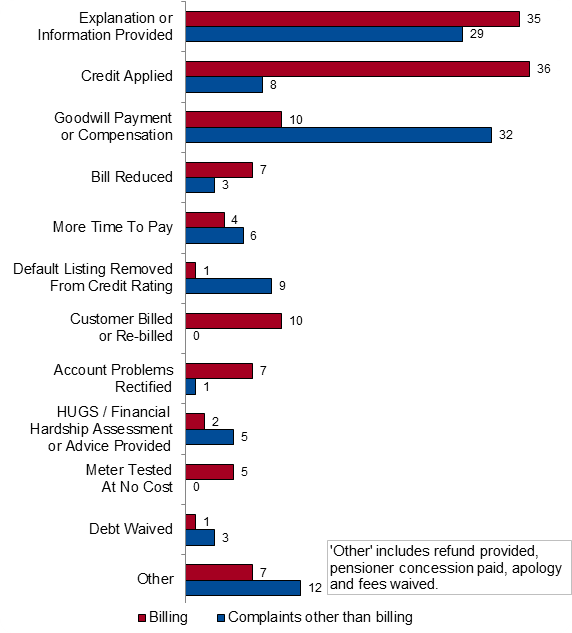Our work in 2016-17
Complaints and Enquiries Received
Over the 12 month period from 1 July 2016 to 30 June 2017, the Energy and Water Ombudsman received 2,478 complaints and closed 2,499 complaints. In addition
114 enquiries were received. The following chart shows the breakdown of complaints and enquiries received for gas, electricity and water in 2016-17.
| Complaints and Enquiries Received in 2016-17
|
Trends in Complaint Numbers
The following chart show the trend in complaint numbers over the last five years for electricity, gas and water complaints.
Complaints Received from 2012-13 to 2016-17 |
NOTE: The water jurisdiction commenced on 1 January 2014. Accordingly, water complaints in 2013-14 represent a six month period, not a full year.
Further details of the trends in electricity complaints over the last five years are shown in the following chart. After a significant increase in electricity complaints in 2009-10 and 2010-11, there has been a significant decrease over the past five years, including a 31% decrease in 2013-14, a further 25% decrease in 2014-15 and a further 14% decrease in 2015-16. In 2016-17, there has been a 26% increase in electricity complaints, however, complaint numbers remain below the levels in 2012‑13 and 2013-14.
| Electricity Complaints Received by Month 2012-13 to 2016-17 |
View a visually accessible version of the above chart.
Complaints Finalised
Complaints are finalised through resolution by the electricity, gas or water provider where possible and, if the matter cannot be resolved at that level, the complaint is investigated. The complaint stages and action taken by the Energy and Water Ombudsman at each stage are shown below.
Stage 1 Complaints |
The person has not yet contacted the electricity, gas or water provider. The person is referred to the relevant provider. |
Stage 2 Complaints |
The person has had at least one contact with their electricity, gas or water provider (such as contact to the call centre) but the complaint has not been resolved. The Energy and Water Ombudsman refers the complaint to a ‘higher level’ officer for resolution within 10 business days. |
Investigated Complaints |
If a complaint remains unresolved after it has been referred to a ‘higher level’ officer at the relevant provider, the person can bring their complaint back to the Energy and Water Ombudsman for investigation. Where appropriate, the Energy and Water Ombudsman may attempt to facilitate a resolution. |
In 2016-17, there were 2,499 complaints closed, comprising 1,766 electricity complaints, 363 gas complaints and 370 water complaints.
Timeliness of Complaint Handling
The Energy and Water Ombudsman has maintained its high levels of timeliness in 2016-17 with 83% of electricity complaints, 96% of gas complaints, 89% of water complaints and 86% of all complaints being finalised within 10 business days. More specifically, 97% of Stage 1 and Stage 2 complaints were finalised on the same working day they were received and over 99% by the end of the second work day. Of matters for investigation, over 66% were finalised within three months, with over half of these finalised within the first month, and over 93% were finalised within 6 months.
The following charts show the timeframes for resolving electricity, gas and water complaints in 2016-17.
| Time to Close Complaints in 2016-17
|
Percentage of Complaints Closed in 10 Work Days in 2016-17 |
Issues Raised in Complaints
| Billing | Complaints about bills including alleged errors and disputes over meter readings and fees and charges. |
| Credit | Complaints about payment arrangements, debt collection issues and payment difficulties. |
| Customer Service | Complaints about alleged poor customer service. |
| Supply | Complaints about the quality and reliability of supply of electricity, gas or water. |
| Provision | Complaints about connection issues. |
| Land | Complaints about the way a provider has exercised its powers in relation to land. |
| Service Standard Payments | Complaints about regulated payments for poor service. |
| Transfer | Complaints about transfers from one provider to another. |
| Marketing | Complaints about the marketing activities of providers. |
| Drainage, Irrigation or Sewerage | Complaints about the supply of drainage, irrigation or sewerage. |
| General | Complaints not covered by other categories, including complaints by a person affected by a water service. |
Issues raised in electricity, gas and water complaints fall into the following categories:
Most Common Issues Raised
As for previous years, during 2016-17, billing remains the most common issue raised for electricity, gas and water complaints. Billing issues were raised in 48% of complaints received (44% of electricity complaints, 55% of gas complaints and 61% of water complaints). During the year there has been an increase in billing complaints of 42% for electricity, 53% for gas and 55% for water.
Credit is also a common issue for energy complaints, and credit issues were raised in 25% of complaints received (28% of electricity complaints, 27% of gas complaints and 6% of water complaints).
The following charts show the trends in issues raised in complaints over the last five years.
Electricity Issues
2012-13 to 2016-17 |
Gas Issues 2012-13 to 2016-17 |
Water Issues
2013-14 to 2016-17 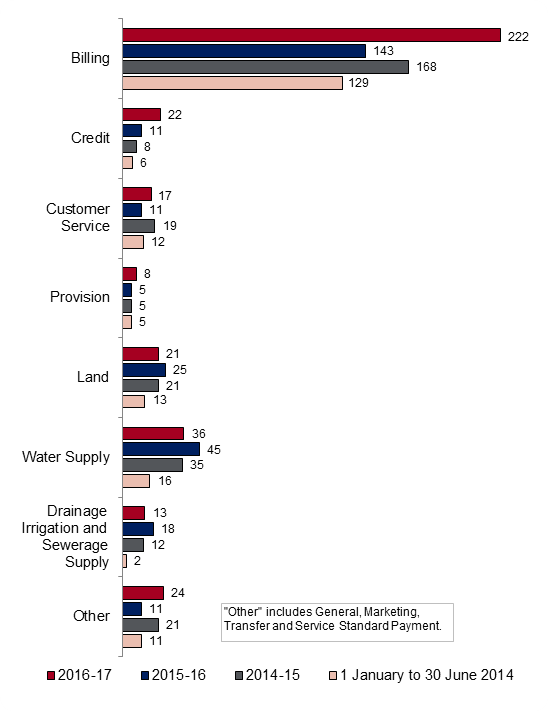 |
NOTE: The water jurisdiction commenced on 1 January 2014. Accordingly, water complaints in 2013-14 represent a six month period, not a full year.
Reasons for Billing and Credit Complaints
Complaints about billing and credit issues may be made for a range of reasons. The main types of billing and credit issues are:
| Types of Billing Issues | ||
| High Bill | Bill higher than expected. | |
| Alleged Error | Alleged billing errors. | |
| Meter | Metering issues. | |
| Non Application | Disconnections due to the customer not applying for an account. | |
| Tariff | Incorrect rates or lack of information about tariffs. | |
| Fees | Fees and charges. | |
| Pensioner Rebate | Rebate has not been applied or has been incorrectly applied. | |
| Format | Format or lack of adequate information on bill. | |
| Other | Includes backbills, GST, historical debt, payment periods and security deposit. | |
| Types of Credit Issues | ||
| Payment of Arrears | Payment of arrears from previous bills, including extensions and payment plans. | |
| Debt Collection | Credit rating or debt collection issues. | |
| Bill and Debt Payments | Customer has received a high bill and has difficulty in payment, has difficulty paying debts or problems with payment arrangements. | |
In 2016-17, the main reasons for electricity billing complaints were high bills and alleged errors. For gas billing complaints, the main reasons were high bills, alleged errors, meters and fees. For water billing complaints, the main reasons were high bills, alleged errors and fees.
For electricity, gas and water complaints, the main reason for credit complaints were payment of arrears and, for electricity and gas complaints, debt collection.
The trends over the last five years in the different types of billing and credit issues are shown in the following charts.
Types of Billing and Credit Issues for Electricity
2012-13 to 2016-17 |
| Types of Billing and Credit Issues for Gas
2012-13 to 2016-17
|
| Types of Billing and Credit Issues for Water
2013-14 to 2016-17
|
NOTE: The water jurisdiction commenced on 1 January 2014. Accordingly, water complaints in 2013-14 represent a six month period, not a full year.
Disconnections
Gas and electricity retailers sometimes disconnect supply when a customer has failed to pay their bill or has not applied for an account when they take up a new residence. Before disconnecting, a reminder notice and then a disconnection warning should be sent. Complaints about reminder notices and disconnection warnings are recorded by the Energy and Water Ombudsman as impending disconnections. Complaints about a disconnection that has already occurred are recorded as actual disconnections. Water providers typically restrict a service rather than disconnect.
During 2016-17, there were:
- 1,270 electricity complaints involving billing and credit issues and, of these, 241 involved actual disconnection and 92 involved an impending disconnection;
- 305 gas complaints involving billing and credit issues and, of these, 63 involved actual disconnection and 5 involved an impending disconnection; and
- 244 water complaints involving billing and credit issues and, of these none related to actual water restriction or disconnection and 5 involved an impending water restriction.
The following charts show trends for electricity and gas complaints relating to billing and credit issues involving, and not involving, disconnections.
For electricity, there was a decrease in complaints about actual disconnections in 2012-13, from 338 in 2011-12. Disconnections remained steady in 2013-14 and 2014-15, followed by a 34% decrease in 2015-16. In 2016-17 there was an increase in complaints about actual disconnections, with levels now similar to 2014-15.
| Electricity Disconnections 2012-13 to 2016-17
|
For gas, complaints about actual disconnections have been higher in the last three years compared to previous years.
| Gas Disconnections
2012-13 to 2016-17
|
Actual or impending disconnections can occur for the following reasons:
| Reasons for Disconnection | |
| Arrears and Backbills | Customer has not paid their bill or a backbill for a previous period. |
| Non Application | The customer has moved into or acquired a property and not applied to their retailer for an account to be established. |
| Alleged Error | Customer claims that they have been, or are about to be, disconnected due to an alleged error by the retailer. |
For both electricity and gas, most complaints received about disconnections relate to arrears in bill payments. The following charts show the trends in the reasons for all disconnections (actual and impending) over the last five years.
| Electricity Disconnections
2012-13 to 2016-17
|
| Gas Disconnections
2012-13 to 2016-17
|
The following case study illustrates the issues raised in complaints about disconnections. Resolution of this case involved two providers, the distributor and the retailer.
 Energy and Water Ombudsman assists in keeping customer connected
Energy and Water Ombudsman assists in keeping customer connected
An elderly customer was living in an area in regional Western Australia where customers were required to read their own meter. The customer had agreed to provide regular meter readings as part of a repayment agreement for an outstanding debt but had not made the required readings, due to an illness which meant they could not access the meter. When an accurate meter reading was carried out by the Distributor, it showed a significant increase in consumption. This meant that, while the customer was making regular payments, these were not sufficient to meet ongoing electricity consumption and, as a result, the customer’s debt had increased. The customer complained when they were disconnected for failing to provide regular meter readings as required by the repayment agreement.
The investigation by the Energy and Water Ombudsman confirmed that the meter box was some distance from the residence, located high on a pole, and it was unsafe for the customer to read the meter due to their illness. The investigation also revealed that the customer had not informed the Retailer of their difficulty in reading the meter.
The Energy and Water Ombudsman liaised with both the Distributor and Retailer to facilitate a resolution and, as a result, a reconnection was arranged by the Retailer with bi-monthly meter readings to be undertaken by the Distributor. The resolution ensured the customer’s safety and the Retailer was able to further assist the customer by establishing a suitable payment plan based on timely meter readings.
Investigated Complaints
The Energy and Water Ombudsman refers complaints to the electricity, gas or water services provider to resolve the matter in the first instance and most complaints are resolved directly between the customer and the provider. If the customer does not consider the matter is resolved they can bring their complaint back to the Energy and Water Ombudsman for investigation.
Facilitated Resolution Prior to Investigation
Prior to investigation, where appropriate, the Energy and Water Ombudsman may attempt to facilitate a resolution between the customer and the provider before commencing an investigation.
The facilitated resolution process involves the Office contacting the provider to allow it a further two business days to try to resolve the complaint and working with both the customer and the provider to facilitate a resolution. The Office monitors the process to ensure the matter is resolved. If the provider does not wish to attempt a further resolution or there is not a resolution in a reasonable timeframe, the complaint is investigated.
In 2016-17, there were 350 complaints finalised after being referred back by the customer for investigation, of which 119 (34%) were finalised through a facilitated resolution prior to investigation, 100 for electricity, nine for gas and 10 for water.
 Energy and Water Ombudsman facilitates a correct payment
Energy and Water Ombudsman facilitates a correct payment
A family member complained about delays in receiving a correct refund cheque for their parent’s deceased estate, after a cheque was sent to them by the provider which they said was incorrectly made out to the parent, rather than the estate. Following a facilitated resolution by the Energy and Water Ombudsman, a new cheque was issued which resolved the complaint.
Investigations Finalised
In addition to the 119 complaints finalised through a facilitated resolution prior to investigation, there were 231 complaints finalised in 2016-17 following an investigation by the Energy and Water Ombudsman, including 192 electricity complaints, seven gas complaints and 32 water complaints.
As shown in the following chart, consistent with an increase in electricity complaints received, the number of investigated electricity complaints in 2016-17 has increased compared to 2015-16. The numbers of investigated gas and water complaints have remained similar to 2015-16.
| Number of Investigations Finalised
2012-13 to 2016-17
|
NOTE: The water jurisdiction commenced on 1 January 2014. Accordingly, water investigations finalised in 2013-14 represent a six month period, not a full year.
Compared to 2015-16, in 2016-17, there has been an increase in the proportion of electricity complaints and a decrease in the proportion of gas and water complaints finalised after an investigation, as shown in the following chart.
| Investigations Finalised as Percentage of Complaints Finalised 2012-13 to 2016-17 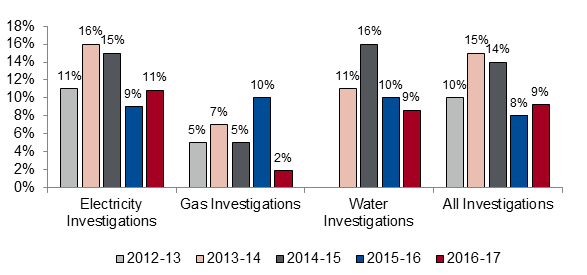 |
Outcomes of Complaints Referred Back for Investigation
Complaints that are referred back by a customer to the Energy and Water Ombudsman for investigation may be finalised for the following reasons:
- The Energy and Water Ombudsman facilitates a resolution prior to the commencement of an investigation;
- The Energy and Water Ombudsman facilitates a resolution during the investigation;
- Investigation of the matter shows that it is out of jurisdiction;
- The investigation shows the complaint is not sustained;
- The investigation shows the matter is sustained and the Energy and Water Ombudsman makes a binding determination, including an appropriate remedy; or
- Further investigation is not warranted for a range of reasons.
The most common outcomes for the 350 complaints finalised in 2016-17 after being referred back for investigation were as follows:
- In 119 (34%) of the 350 complaints, a resolution between the customer and the provider was facilitated prior to commencing an investigation;
- In 39 (11%) of the 350 complaints, a resolution between the customer and the provider was facilitated during the investigation; and
- In 180 (51%) of the 350 complaints, the investigation showed the complaint was not sustained.
Smaller proportions of complaints are finalised because they are found, during the investigation, to be out of jurisdiction (seven in 2016-17) or further investigation is not warranted (five in 2016-17).
There were no binding determinations by the Energy and Water Ombudsman in the 2016-17 reporting period.
Outcomes of Electricity Complaints Referred Back for Investigation
The following chart shows the outcomes, in 2016-17, of the 292 electricity complaints referred back for investigation, broken down by billing (the most common issue raised in complaints) and other issues.
Outcome of Electricity Complaints Referred Back for Investigation in 2016-17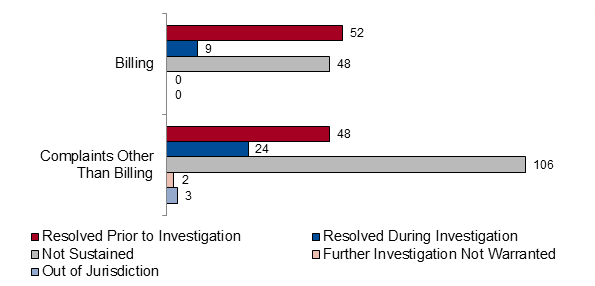 |
Outcomes of Gas Complaints Referred Back for Investigation
In 2016-17, the outcomes of the 16 gas complaints referred back for investigation were that nine were resolved prior to investigation, five were not sustained, and in two, further investigated was not warranted.
Outcomes of Water Complaints Referred Back for Investigation
In 2016-17, the outcomes of the 42 water complaints referred back for investigation were that 10 were resolved prior to investigation, six were resolved during the investigation, 21 were not sustained, four were out of jurisdiction and in one, further investigation was not warranted.
Resolutions for Complaints
Electricity, gas and water providers may offer a range of actions to resolve a complaint including reducing bills, correcting or removing credit listings, providing the complainant with more time to pay, or providing compensation, an explanation or an apology. Bills may be reduced for a variety of reasons including correction of errors (for example, payment of rebate entitlements). Compensation may be paid where a customer has suffered a loss or damage due to the actions of their electricity, gas or water provider.
Resolutions for Electricity Complaints
In 2016-17, there were 233 actions offered by electricity providers to resolve the 133 electricity complaints that were resolved during the year after being referred back by the customer to the Energy and Water Ombudsman for investigation. The number of actions undertaken is higher than the number of complaints resolved as there is often more than one action taken by the provider to resolve the complaint. For example, the retailer may reduce the bill and offer an apology.
The following chart provides the breakdown of the actions offered in 2016-17 to resolve complaints, for billing complaints and complaints about other issues.
| Resolutions for Electricity Complaints in 2016-17
|
Resolutions for Gas Complaints
There were 18 actions offered by gas providers for the nine gas complaints that were resolved in 2016-17 after they were referred back for investigation, including:
- Explanation or information provided;
- Bill reduced, refund provided or goodwill payment or compensation; and
- HUGS or financial hardship assessment provided, or more time to pay.
Resolutions for Water Complaints
There were 25 actions offered by water providers for the 16 water complaints that were resolved in 2016-17, after they were referred back for investigation, including:
- Explanation or information provided;
- Bill reduced, credit applied or goodwill payment or compensation;
- Customer billed or re-billed or account problems rectified; and
- Default listing removed from credit rating or debt waived.
The following case studies illustrate the resolutions offered by providers.
Energy and Water Ombudsman involvement leads to removal of credit listing
A customer complained that, after they had informed their Retailer that they were moving and that the account was to be transferred to housemates, the Retailer continued to send bills in the customer’s name to the old address. These bills were unpaid which resulted in the Retailer listing a default on the customer’s credit rating. When the customer became aware of the credit listing, they paid the debt in full but the listing remained and affected their ability to obtain credit.
The investigation by the Energy and Water Ombudsman revealed that the Retailer was aware that the customer had moved, but continued to send bills for consumption to the customer at the old address. As a result, the Retailer reimbursed the customer for consumption that occurred after the customer informed the Retailer that they were moving and removed the credit listing.
Investigation of damage to appliance
A customer complained that following a routine meter exchange by the Distributor, an electrical appliance was found to be damaged but the Distributor would not compensate them for the damage.
As part of the Energy and Water Ombudsman’s investigation, independent technical advice was sought from EnergySafety, who is responsible for the technical and safety regulation of the electrical industry in Western Australia. EnergySafety confirmed that the correct procedure, substantiated by documented tests undertaken by the Distributor, had been followed during the meter exchange, which included switching off the supply during the meter changeover, and that this would prevent any possible harmful high or low voltages being applied to appliances.
The Energy and Water Ombudsman informed the customer that the decision by the Distributor to decline their claim for damage to the appliance was reasonable.
Go to next section of Annual Report >>
Go to previous section of Annual Report >>
Go back to Annual Reports page >>
Download Our work in 2016-17 as a PDF >>
Our publications are available download in portable document format (PDF). To open PDFs you will require Adobe Reader which can be downloaded for free at https://get.adobe.com/reader/.




